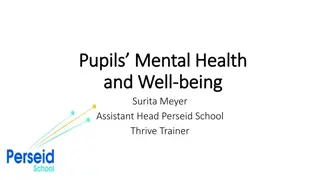Ethical and Legal Issues in Mental Health Nursing: Ensuring Patient Rights and Safety
Historically, individuals with mental illness faced limited rights and inhumane treatment. The shift in laws and recognition of patient rights in the 1970s improved the conditions for mental health clients. Legal issues in psychiatric nursing cover patient rights, including treatment refusal, informed consent, and the least restrictive environment. The Patient's Bill of Rights outlines key entitlements, like confidentiality and fair treatment review processes. Restraints and seclusion are used cautiously to manage aggressive behavior, with seclusion providing a controlled environment for clients to regain composure.
Download Presentation

Please find below an Image/Link to download the presentation.
The content on the website is provided AS IS for your information and personal use only. It may not be sold, licensed, or shared on other websites without obtaining consent from the author.If you encounter any issues during the download, it is possible that the publisher has removed the file from their server.
You are allowed to download the files provided on this website for personal or commercial use, subject to the condition that they are used lawfully. All files are the property of their respective owners.
The content on the website is provided AS IS for your information and personal use only. It may not be sold, licensed, or shared on other websites without obtaining consent from the author.
E N D
Presentation Transcript
University of Basra College of Nursing Psychiatric Mental Health Nursing Ethical And Legal Issues In Mental Health Nursing Assist. Lec. Doaa M. Bachi
INTRODUCTION Historically, clients with mental illness had few rights and were subjected to institutionalization, warehousing, and inhumane treatment. In the 1970s, recognition of patient s rights and changes in laws governing commitment improved the rights of clients.
1.1. Legal Issues in Psychiatric Mental Health Nursing 1. Rights of psychiatric patient A. Right to receive and refuse treatment B. Right to inform consent C. Right to be treated in the least restrictive environment D. Right to refuse to participate in research E. Any restrictions (e.G., Mail, visitors, clothing) must be made for a verifiable F. Right to have or refuse visitors G.Right to send and receive sealed mail
Patients Bill of Rights 1. To be informed about benefits, qualifications of all providers, available treatment options, and appeals and grievance procedures Least restrictive environment to meet needs 2. Confidentiality 3. Choice of providers 4. Treatment determined by professionals, not third-party payers 5. Parity 6. Nondiscrimination 7. All benefits within scope of benefit plan 8. Treatment that affords greatest protection and benefit 9. Fair and valid treatment review processes
2.Restraints and seclusion Restraint is the direct application of physical force to a person without his or her permission to restrict his or her freedom of movement. The physical force may be human or mechanical or both. Human restraint occurs when staff members physically control the client and move him or her to a seclusion room. Mechanical restraints are devices, usually ankle and wrist restraints,fastened to the bed frame to curtail the client s physical aggression, such as hitting, kicking,and hair pulling.
Seclusion is the involuntary confinement of a person in a specially Constructed, locked room equipped with a security window or camera for direct visual monitoring. Seclusion decreases stimulation, protects others from the client, prevents property destruction, and provides privacy for the client. The goal is to give the client the opportunity to regain physical and emotional self-control.
Short-term use of restraint or seclusion is permitted only when the client is imminently aggressive and dangerous to him or herself or to others, and all other means of calming the client have been unsuccessful. For adult clients, use of restraint and seclusion requires a face-to-face evaluation by a licensed independent practitioner within 1 hour of restraint or seclusion and every 8 hours thereafter, a physician s order every 4 hours, documented assessment by the nurse every 1 to 2 hours, and close supervision of the client. For children, the physician s order must be renewed every 2 hours, with a face-to-face evaluation every 4 hours.The nurse assesses the client for any injury and provides treatment as needed.
Staff must monitor a client in restraints continuously on a one-to-one basis for the duration of the restraint period. A client in seclusion is monitored one-to-one for the first hour and then may be monitored by audio and video equipment. The nurse monitors and documents the client s skin condition, blood circulation in hands and feet (for the client in restraints), emotional well-being, and readiness to discontinue seclusion or restraint. He or she observes the client closely for side effects of medications, which may be given in large doses in emergencies. The nurse or designated care provider also implements and documents offers of food, fluids, and opportunities to use the bathroom per facility policies and procedures.
3.Duty toWarnThird Partieshird Parties: One exception to the client s right to confidentiality is the duty to warn, based on the California Supreme Court decision in Tarasoff vs. Regents of the University of California As a result of this decision, mental health clinicians may have a duty to warn identifiable third parties of threats made by clients, even if these threats were discussed during therapy sessions otherwise protected by privilege.
4.Insanity Defense One legal issue that sparks controversy is the insanity defense, with insanity having a legal meaning but no medical definition. The argument that a person accused of a crime is not guilty because that person cannot control his or her actions or cannot understand the wrongfulness of the act is known as the M Naghten Rule.
5. Nursing Liability Nurses are responsible for providing safe, competent, legal, and ethical care to clients and families. Professional guidelines such as the American Nurses Association s (ANA s) Code of Ethics for Nurses with Interpretive Statements and the ANA s Psychiatric Mental Health Nursing: Scope and Standards of Practice outline the nurse s responsibilities and provide guidance. Nurses are expected to meet standards of care, meaning the care they provide to clients meets set expectations and is what any nurse in a similar situation would do.
6.Tort Tortis a wrongful act that results in injury, loss, or damage. Torts may be either unintentional or intentional. 1.Unintentional torts: negligence and malpractice. Negligence is an unintentional tort causing harm by failing to do what a reasonable and prudent person would do in similar circumstances Malpractice is a type of negligence that refers specifically to professionals such as nurses and physicians.Clients or families can file malpractice lawsuits in any case of injury,loss,or death.
For a malpractice suit to be successful, that is, for the nurse, physician, or hospital or agency to be liable, the client or family needs to prove four elements: 1. Duty: A legally recognized relationship (i.e., physician to client, nurse to client) existed. The nurse had a duty to the client, meaning that the nurse was acting in the capacity of a nurse. 2. Breach of duty: The nurse (or physician) failed to conform to standards of care, thereby breaching or failing the existing duty. The nurse did not act as a reasonable, prudent nurse would have acted in similar circumstances. 3. Injury or damage: The client suffered some type of loss, damage, or injury. 4. Causation: The breach of duty was the direct cause of the loss, damage, or injury. In other words, the loss, damage, or injury would not have occurred if the nurse had acted in a reasonable,prudent manner
2. Intentional torts Psychiatric nurses may also be liable for intentional torts or voluntary acts that result in harm to the client. Examples include assault, battery,and false imprisonment. Assault involves any action that causes a person to fear being touched in a way that is offensive, insulting, or physically injurious without consent or authority. Examples include making threats to restrain the client to give him or her an injection for failure to cooperate. Battery involves harmful or unwarranted contact with a client; actual harm or injury may or may not have occurred. Examples include touching a client without consent or unnecessarily restraining a client False imprisonment is defined as the unjustifiable detention of a client, such as the inappropriate use of restraint or seclusion.
1.2. . Ethical issues of mental health nursing Ethics - is a branch of philosophy that deals with values of human 1.2 Ethical issues of mental health nursing conduct related to the rightness or wrongness of actions and to the goodness and badness of the motives and ends of such actions Ethical theories are sets of principles used to decide what is morally right or wrong. such as utilitarianism (the greatest good for the greatest number) and deontology (using principles such as autonomy, beneficence, nonmaleficence, justice, veracity, and fidelity), to make ethical decisions.
Ethical principles 1. 1. Autonomy: refers to a person s right to self-determination and independence 2. 2. Beneficence refers to ones duty to benefit or promote the good of others 3. 3. Nonmaleficences is the requirement to do no harm to others either intentionally or unintentionally
4. Justice refers to fairness, treating all people fairly and equally without regard for social or economic status, race, sex, marital status, religion, ethnicity, or cultural beliefs. 5. Veracity principle that refers to one s duty to be truthful always. 6. Fidelity refers to the obligation to honor commitments and contracts
Ethical dilemmas are situations that arise when principles conflict or when there is no single clear course of action in a given situation. For example, the client who refuses medication or treatment is allowed to do so on the basis of the principle of autonomy Many ethical dilemmas in mental health involve a conflict between the client s autonomy and concerns for the public good (utilitarianism). EX: Can consumers of mental health care truly be empowered if health care professionals step in to make decisions for them for their own good? Should physicians break confidentiality to report clients who drive cars at high speeds and recklessly?























